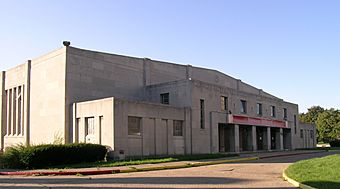Detroit Naval Armory facts for kids
|
Detroit Naval Armory
|
|
 |
|
| Location | 7600 East Jefferson Avenue Detroit, Michigan |
|---|---|
| Built | 1930 |
| Architect | William Buck Stratton |
| Architectural style | Art Deco, Art Moderne |
| NRHP reference No. | 94000662 |
Quick facts for kids Significant dates |
|
| Added to NRHP | July 1, 1994 |
The Detroit Naval Armory is a historic building in Detroit, Michigan. It is located at 7600 East Jefferson Avenue. This important building is also known as the R. Thornton Brodhead Armory. It was recognized as a Michigan State Historic Site in 1980. Later, in 1994, it was added to the National Register of Historic Places. This means it is a special place worth protecting.
Contents
What Does It Look Like?
The Detroit Naval Armory is made of limestone. It has four main parts. These include an entrance area, a large drill hall, an office section, and another drill hall. The building shows off two cool styles of architecture: Art Deco and Art Moderne. These styles were popular in the 1920s and 1930s.
Inside, you can find lots of art with a nautical (sea-themed) feel. This art was created by artists like John Tabaczuk and Edgar Yaeger. The main entrance faces East Jefferson Avenue. It is decorated with military and naval designs. These designs are made from special Pewabic tiles.
Outside the building, there's a curved driveway. In the middle, you'll see a flagpole. It was put there in 1942 to honor Captain R. Thornton Brodhead. There is also a large Navy anchor. This anchor came from the USS Yantic. The Yantic was a gunboat used during the American Civil War.
A Look Back in Time
In the 1880s, some states started "naval militias." These groups were like early versions of today's Navy and Marine Corps Reserve units. Michigan created its own Michigan Naval Militia in 1893. Many wealthy people in Detroit enjoyed joining this militia. Even so, the militia members fought in both the Spanish–American War and World War I.
By 1929, more than 600 men were part of the Michigan Naval Militia. Their old headquarters was too small. Captain Richard Thorton Brodhead helped convince the Michigan state government to build a new place. The state and the city of Detroit worked together. They gathered $375,000 to build the new armory. It was built on Jefferson Avenue, close to the Belle Isle bridge.
Opening and Early Uses
The new armory opened its doors in 1930. It was used for training Navy reservists. But it was also a popular spot for community events. The large indoor drill floor hosted many activities. People came for dances, USO mixers, and even car shows. Political meetings and sports events were also held there.
A famous moment happened in 1932. Future heavyweight boxing champion Joe Louis had his very first professional fight there!
Improvements by the WPA
Between 1936 and 1939, the armory got some big upgrades. These improvements were made possible by the Works Progress Administration (WPA). The WPA was a special program during the Great Depression. It helped people find jobs by building public projects across the United States.
The WPA project added a basement garage and a gym. The third floor was made bigger. This added an officer's dining room, a mess hall, and a kitchen. A new penthouse wing was built on the fourth floor. This area was for visiting officers.
Amazing Art Inside
The WPA also paid for many artworks inside the armory. These art pieces were created between 1936 and 1941. Captain Brodhead and the architect, William Stratton, loved the idea from artist David Fredenthal. They changed a whole wall in the officer's dining room. It now included bookshelves and a fireplace.
Fredenthal and his helpers painted a large mural there. It showed different scenes from life on a ship. He also painted a smaller mural in the nearby bar area. Another artist, Edgar Yaeger, painted a mural on all four walls of the mess hall. One of his assistants, John Tabaczuk, carved about 20 designs for the wooden doors. He also carved a fun banister for the stairs leading to the penthouse.
Gustave Hildebrand, with James Johnson, created amazing art at the main east entrance. They carved plaster on the walls. This created 800 feet of art showing daily life for sailors. This collection of WPA art is very special. It is the largest group of federally funded art from the Depression era in Michigan. Experts say it has the "richest WPA art collection" in the state. It also has the most different types of art in one place.
Later Years
During World War II, the armory was very busy. It was used as a place for Navy sailors to live. It also became a school for training sailors in diesel engines and electricity. After the war, it went back to being a training center for reservists.
The armory was later renamed the R. Thornton Brodhead Armory. This was to remember its first Naval leader, Captain Brodhead. Until 2004, the armory was home to Marines and Sailors. These were from Headquarters and Service Company, 1st Battalion, 24th Marines.
As of 2008, there were plans to fix up the armory. The idea was to add bowling lanes, a fitness center, and a youth boxing club.


